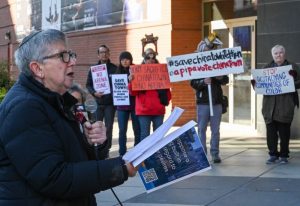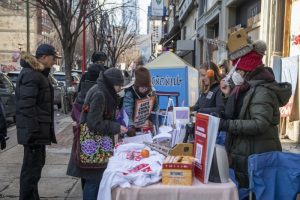
On Dec. 25, Jewish Philadelphians flocked to Chinatown for more than just dim sum.
A group of demonstrators, many of whom were Jewish, brought signs, a larger-than-life dreidel and electric menorahs to the Friendship Gate at 10th and Arch streets, protesting against the construction of the 175,000-square-foot, $1.3 billion 76 Place.
The proposed 76ers arena would occupy the Market East district, replacing part of the Fashion District Philadelphia mall and Greyhound station on Market Street between 10th and 11th streets, ending less than a block from Chinatown.
“Let’s save our Chinatown, pa-rump-pa dim sum,” protesters sang to the tune of “Little Drummer Boy”.
According to organizer Debora Kodish, about 200 people stopped by the table at 10th and Arch to learn more about the protest or express support.
“It just seems really important that we hold on to this, maybe the last large remaining community of color in Center City, Philadelphia,” Kodish said.
“We need everybody to stand up for Chinatown,” she continued. “We don’t want people in Chinatown to feel like it’s just their small battle because it affects all of us.”
The group of Jewish protesters has dubbed themselves the No Arena in Chinatown Solidarity group (pronounced as “naches,” the Yiddish word for “pride” or “satisfaction”). They are part of a coalition of groups, many led by Chinatown residents and Asian American leaders, protesting against the development of the arena.
“It’s a form of predatory development for the city writ large, but for Chinatown, it would absolutely destroy the community,” said Debbie Wei, co-founder of Asian American United, a group to “grow leadership in Asian American communities to build our neighborhoods and unite against oppression.”
According to Jonathan Waldman, a white, Jewish Chinatown resident married to a Chinese American woman and co-founder of the Concerned Citizens of Chinatown Association, the construction of the arena would gentrify the neighborhood, driving out residents and businesses, some of which have existed in the neighborhood for generations.
Rabbi Linda Holtzman, a spiritual leader of the Tikkun Olam Chavurah, led a menorah lighting, drawing parallels between the “small but mighty” Maccabees who fended off the ancient Greek army and the protesters of the 76 Place construction.
“It was a group of people who saw something that they were deeply upset about, didn’t sit back quietly, and stood up and spoke out,” Holtzman said. “So on the eighth day of Chanukah, it’s so very important as Jews to stand up and say, ‘No, we’re speaking out, too. We’re not letting this happen.’”
The Christmas day protest of 76 Place wasn’t the first time the construction of the arena was deemed a Jewish issue.

On Oct. 21, NACS members and other demonstrators gathered outside of Kimmel Center’s Verizon Hall to protest while the Jewish Federation Real Estate group hosted its 10th annual Legends and Leaders event inside, honoring Jewish Federation co-chair and JFRE founder David Adelman, who is also the chair of 76 Devcorp, the development group behind 76 Place.
“People have the right to free speech; they have the right to protest. They have the right to disagree with our plan,” Adelman said of the protest. “I just hope it’s based on a premise of solid foundation of truth.”
According to Adelman, the plans for 76 Place would not interfere with Chinatown and only supplant the now-defunct entertainment center.
“We’re utilizing existing infrastructure and placing something there,” he said.
Adelman acknowledged that previous development projects, such as the Vine Street Expressway, which cut Chinatown in half, were detrimental to the neighborhood.
He also addressed Philadelphia Chinatown protesters’ concerns that the development of 76 Place would result in a similar fate to that of Washington, D.C.‘s Chinatown, whose Capital One Arena gentrified the area and displaced Chinatown’s immigrant residents. Unlike the Vine Street Expressway and Capital One Arena projects, 76 Place is not a result of eminent domain, meaning that, according to Adelman, the project will not displace residents.
Adelman also plans to invest in affordable housing and increased security in the neighborhood. He said 76 Devcorp has met with 25-30 groups of 20-200 people, most of which are Chinatown residents or other concerned parties.
“I want to be cognizant of the facts and always listen to concerns,” he said. “That’s why we’re unveiling this project eight years in advance.”
Still, Chinatown residents are concerned about the implications of the arena’s construction, which is slated to last six years.
“The crowding, the pollution and dust and debris and the traffic for six years — that will be in Chinatown for sure,” Waldman said.
He predicts that Chinatown as residents know it will be gone in the next 10-15 years anyway. With the construction of 76 Place, Waldman worries the neighborhood won’t last the next six.






